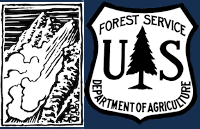Snowpack and Avalanche Discussion
<p>Strong south and west winds are hammering the mountains across the forecast area. In Cooke City and West Yellowstone, they are transporting recent snow into thick drifts that are likely to avalanche on steep slopes. The added weight of this wind-drifted snow may result in very large slides breaking on weak layers near the base of the snowpack. Several inches of snow falling this morning will worsen the problem of <strong>wind slab </strong>and <strong>persistent slab avalanches. </strong></p>
<p>Yesterday, riders and skiers observed avalanches in the Cooke City and Lionhead areas. These primary failed where wind-drifted snow loaded steep slopes and broke as <strong>wind slab avalanches. </strong>Many of these slides occurred on north through east aspects, loaded by the predominantly southwest winds.</p>
<p>On non-wind-loaded slopes, <strong>persistent slab avalanches</strong> may break 1-3 feet deep on buried weak layers of facets and surface hoar formed during last week’s high pressure. These will break widely and may be triggered remotely from nearby areas. We will not be surprised to hear about a few very large avalanches failing on older weak layers buried near the base of the snowpack before this storm cycle is over.</p>
<p><strong>Some notable avalanche highlights include: </strong></p>
<ul>
<li>Large avalanche on the north side of Crown Butte (<a href="https://www.mtavalanche.com/images/25/crown-butte-avalanche"><strong><s…;)</li>
<li>Slide that broke hundreds of feet wide on the north side of Scotch Bonnet (<a href="https://www.mtavalanche.com/images/25/scotch-bonnet-north-avalanche"><s…;)</li>
<li>Natural avalanche in the northeast bowl of Henderson Mountain that avalanched previously this season (<a href="https://www.mtavalanche.com/images/25/natural-avalanche-mt-henderson-ne…;)</li>
<li>Avalanche on the northeast aspect of Miller Ridge (<a href="https://www.mtavalanche.com/images/25/natural-avalanche-miller-ridge-ne…;)</li>
<li>Large wind slab avalanches broke widely across several slopes along Lionhead Ridge (<a href="https://www.mtavalanche.com/images/25/wind-slabs-lionhead-1"><strong><s… 1</span></strong></a><strong>, </strong><a href="https://www.mtavalanche.com/images/25/wind-slabs-lionhead-2"><strong><s…;, </strong><a href="https://www.mtavalanche.com/images/25/wind-slabs-lionhead-3"><strong><s…;)</li>
</ul>
<p><span>Use cautious route-finding and conservative decision-making to avoid wind-loaded slopes and limit travel on any slope steeper than 30 degrees. The avalanche danger is CONSIDERABLE.<span> </span></span></p>
<p><span><span><span>Strong winds from the south and southwest continue to build in the Madison and Gallatin Ranges and the mountains around Island Park, with a peak gust of 90 mph on Lone Mountain this morning. Expect unusual loading and drifting patterns. Some mid and upper-elevation slopes will have minimal to no avalanche danger as they have been stripped of snow, and others will have thick drifts and pillows of wind-loaded snow where avalanches are likely. </span></span></span></p>
<p><span><span><span>Yesterday, a skier north of Big Sky intentionally triggered a wind slab avalanche that broke 20” deep and 60 feet wide (<a href="https://www.mtavalanche.com/images/25/shooting-cracks-dudley-creek"><st…;). In Second Yellowmule off Buck Ridge, we saw two small wind slab avalanches on a north aspect while training with USFS Snow Rangers from the Gardiner, Livingston and Bozeman Ranger Districts (<a href="https://www.youtube.com/watch?v=BzI5yK0R7FU"><strong><span>video</span>…;). Avoid wind-loaded slopes where similar <strong>wind slab avalanches </strong>are the most likely problem today. </span></span></span></p>
<p><span><span><span>New and wind-drifted snow sit on persistent weak layers buried 1-3 feet deep on some slopes. Our group found this layer at Buck Ridge yesterday, but we were encouraged because instability was difficult to replicate and many of the weak layers were disrupted (<a href="https://www.mtavalanche.com/node/33980"><strong><span>observation</span…;). This was <em>dissimilar</em> to what Mark and Alex found in the Taylor Fork, where cracks shot 10-50 feet from their sleds (<a href="https://www.mtavalanche.com/node/33944"><strong><span>observation</span…;, <a href="https://www.youtube.com/watch?v=y7Nm5dbbBqQ"><strong><span>video</span>…;). Evaluate for the <strong>persistent slab avalanche problem</strong> by digging 2-3 feet deep and testing for instability as we did in Beehive Basin on Monday <span><span>(</span></span><a href="https://youtube.com/shorts/PBsMPg_BBQw"><strong><span><span>video</span…;) before considering terrain steeper than 30 degrees. </span></span>Shooting cracks, collapsing and recent avalanche activity supersede any indicator of <em>stability. </em></span></span></span></p>
<p><span><span><span>Seek out the elusive slopes sheltered from strong winds. The avalanche danger level is CONSIDERABLE on wind-loaded slopes and MODERATE on other slopes.</span></span></span></p>
<p><span><span><span>Yesterday, in the Bridger Range, three skiers triggered an avalanche on a wind-loaded terrain feature on Saddle Peak that ran 400 vertical feet. Thankfully, no one was caught, and the slide stopped above the large cliffs (<a href="https://www.mtavalanche.com/node/34007"><strong><span>photo</span></str…;). Skiers in the Fairy Lake area reported strong winds and several small <strong>wind slab avalanches </strong>in steep terrain getting loaded by drifting snow (<a href="https://www.mtavalanche.com/node/33976"><strong><span>observation</span…;). Small avalanches on technical slopes, like Saddle Peak and steep Bridger Ridge terrain, can result in tragic outcomes if they sweep skiers or riders off cliffs or into trees. </span></span></span></p>
<p><span><span><span>Similar avalanches are possible today on wind-loaded slopes. Like other parts of the forecast area, strong winds are affecting snow surfaces at many elevations. Some slopes are stripped bare while others are loaded. Seek out terrain sheltered from the wind and avoid steep terrain where indicators of drifting and instability, including shooting cracks or a stiffening of the snow surface, are present. </span></span></span></p>
<p><span><span><span>Human-triggered avalanches are possible, and the avalanche danger is MODERATE. </span></span></span></p>
KING AND QUEEN OF THE RIDGE RESULTS
On Saturday We closed out King and Queen of the Ridge with nearly $30,000 raised! We will post final numbers here after we confirm totals. Thank you to all who participated and raised funds for The Friends of the GNFAC.
